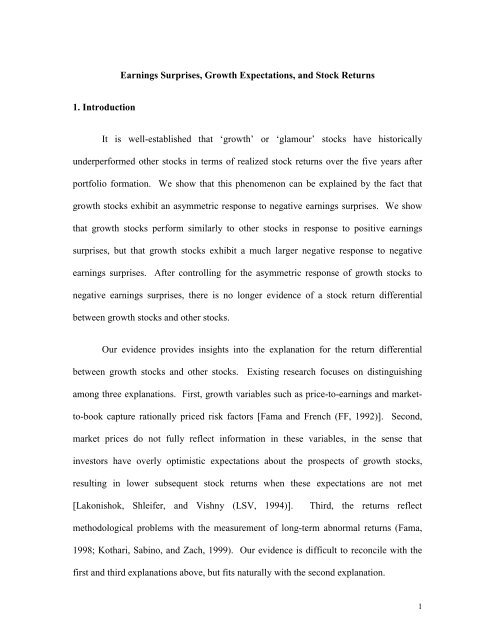Earnings Surprises, Growth Expectations, and Stock Returns:
Earnings Surprises, Growth Expectations, and Stock Returns:
Earnings Surprises, Growth Expectations, and Stock Returns:
Create successful ePaper yourself
Turn your PDF publications into a flip-book with our unique Google optimized e-Paper software.
1. Introduction<br />
<strong>Earnings</strong> <strong>Surprises</strong>, <strong>Growth</strong> <strong>Expectations</strong>, <strong>and</strong> <strong>Stock</strong> <strong>Returns</strong><br />
It is well-established that ‘growth’ or ‘glamour’ stocks have historically<br />
underperformed other stocks in terms of realized stock returns over the five years after<br />
portfolio formation. We show that this phenomenon can be explained by the fact that<br />
growth stocks exhibit an asymmetric response to negative earnings surprises. We show<br />
that growth stocks perform similarly to other stocks in response to positive earnings<br />
surprises, but that growth stocks exhibit a much larger negative response to negative<br />
earnings surprises. After controlling for the asymmetric response of growth stocks to<br />
negative earnings surprises, there is no longer evidence of a stock return differential<br />
between growth stocks <strong>and</strong> other stocks.<br />
Our evidence provides insights into the explanation for the return differential<br />
between growth stocks <strong>and</strong> other stocks. Existing research focuses on distinguishing<br />
among three explanations. First, growth variables such as price-to-earnings <strong>and</strong> market-<br />
to-book capture rationally priced risk factors [Fama <strong>and</strong> French (FF, 1992)]. Second,<br />
market prices do not fully reflect information in these variables, in the sense that<br />
investors have overly optimistic expectations about the prospects of growth stocks,<br />
resulting in lower subsequent stock returns when these expectations are not met<br />
[Lakonishok, Shleifer, <strong>and</strong> Vishny (LSV, 1994)]. Third, the returns reflect<br />
methodological problems with the measurement of long-term abnormal returns (Fama,<br />
1998; Kothari, Sabino, <strong>and</strong> Zach, 1999). Our evidence is difficult to reconcile with the<br />
first <strong>and</strong> third explanations above, but fits naturally with the second explanation.<br />
1







